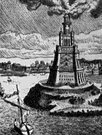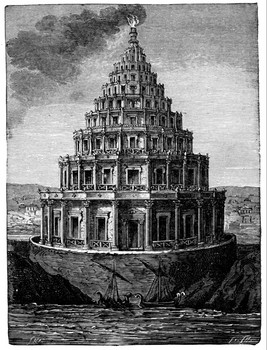The Lighthouse of Alexandria
The Lighthouse of Alexandria was one of the Seven Ancient Wonders of the World. Situated on the small offshore island of Pharos, the Lighthouse lit the way for many a sailor navigating the tricky harbor into what was then one of the world's centers of civilization. Pharos actually was not a true island: It was connected to the mainland by a dike, called the Heptastadion. In this way, Alexandria had two harbors, one on either side of the dike.  The lighthouse was the idea of Ptolemy I, who took over command of Egypt after the death of Alexander the Great. He ordered construction began in 290 B.C. The project was so daunting that it was completed after his death, by his son Ptolemy Philadelphus. The lighthouse was the idea of Ptolemy I, who took over command of Egypt after the death of Alexander the Great. He ordered construction began in 290 B.C. The project was so daunting that it was completed after his death, by his son Ptolemy Philadelphus. The main architect for the project was a man named Sostratus. Detailed calculations for the project were completed at the famed Library of Alexandria. The Lighthouse was a huge building that had three parts, one built right on top of another. The lowest part was square and was 183.4 feet high. The middle was octagonal in shape and was 90 feet high. The highest part was a 24-foot-high cylinder. The total height, including the base, was 384 feet, which would be a 40-story building in modern times. Inside the base was a cylinder that stretched from bottom to top and carried fuel needed to light the fire that burned from the top of the structure. This fire was the beacon during the night. In the daytime, a mirror reflected sunlight and served as the same sort of beacon. (A legend says also that the mirror could be used to burn enemy ships before they could sail into the harbor.) The Lighthouse stood for centuries, first and foremost as a beacon to travelers and next as a tribute to the greatness of Hellenic civilization. Earthquakes eventually brought down the famed structure, however. The first one, in 1303, shook up the entire area; the second one, 20 years later, did significant structural damage. By this time, also, the Lighthouse had fallen into disrepair because the Arab conqueror of Egypt didn't keep it up. Although the Lighthouse soldiered on, it was done in entirely by Sultan Qaitbay in 1480. The sultan used the stone and marble that had once made up the Lighthouse to build a fort on the very spot where the Lighthouse once stood. |
|
Social Studies for Kids
copyright 2002–2026
David White





